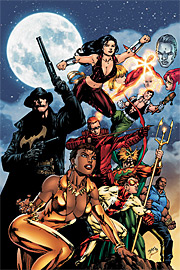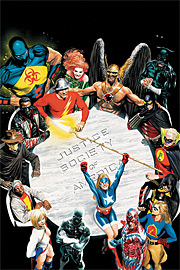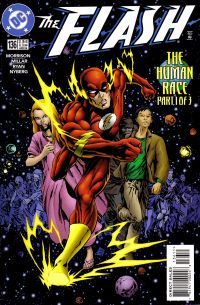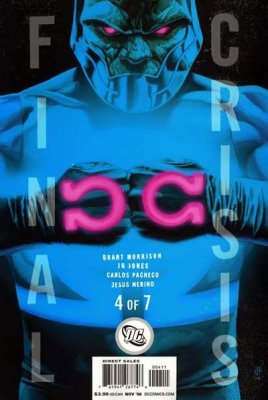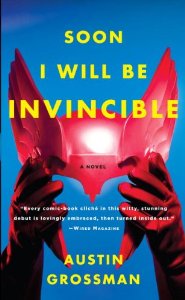
Austin Grossman’s novel Soon I Will Be Invincible is a fun romp through every super-hero cliché ever invented over the history of the genre. Time-travel, cyborgs, telepaths, aliens, evil geniuses, legacy heroes, secret identities, heroes going bad, villains turning good — everything. It’s an affectionate, tongue-in-cheek parody of the tights-and-flights set.
The book is narrated in alternate chapters by Dr. Impossible, a mad scientist who has held the world in his grasp a dozen times, only to be defeated by his arch-nemesis CoreFire — whom he inadvertently created — and by Fatale (as in “Femme”), a small-time cyborg hero who has just been invited to join the world’s premiere super-team, the Champions.
The book opens with Dr. Impossible still in prison, a situation that’s taken care of within the first few chapters. The world’s greatest hero CoreFire is missing, and the Champions, disbanded for nearly a decade after the death of one of their own, have re-gathered to find him. Their number one suspect: Dr. Impossible. Once he escapes, it becomes a race between him and the heroes: will he build his next doomsday device before they capture him? And where is CoreFire?
Dr. Impossible’s megalomaniacal nature (he suffers from “Malign Hypercognition Disorder,” the clinical diagnosis given most evil geniuses) suffuses every sentence as he dwells on his tortured past and schemes to take over the world. By the end of the book, he’s monologued his entire origin, down to the day his eighth grade guidance counselor told him he was a genius, and taken us on a tour of the underworld from its greatest peak to its most pathetic.
Fatale, despite being a high-tech super-soldier who can never live a normal life, comes off as the closest the book has to an ordinary person. She’s still an outsider in the upper echelons, and her loneliness is a constant presence in her chapters. She knows her new colleagues mainly from television, from news footage of their battles and from their celebrity endorsements. (One fundraises for Amnesty International. Another has her own line of beauty products.) While much of Dr. Impossible’s narration consists of flashbacks in which he tells the reader what he already knows, Fatale is entrenched firmly in the present, learning as she goes and relaying her experiences straight to the reader.
The Champions form a sort of dysfunctional Justice League (or is that redundant these days?), with CoreFire, Damsel and Blackwolf as the Superman, Wonder Woman and Batman equivalents. Except in this version, Wonder Woman and Batman are a divorced ex-couple, trying to work together. And Superman’s a bit of a jerk. (But then again…) The team is rounded out by man-tiger Feral, ageless Faerie warrior Elphin (who still has a mission to perform for Titania), magician Mr. Mystic (mainly in the Mandrake/Zatara mold, but with elements of Dr. Strange), teen pop idol Rainbow Triumph, and two newcomers: Fatale herself and Lily, a powerhouse from a distant, blighted future who once fought on the other side of the law. (The book’s website has a database of heroes and villains that doesn’t seem particularly spoilery at first glance.)
The book has its requisite battles, but for the most part it’s about what heroes and villains do in between the fighting: the endless investigations that go nowhere. Bickering at team meetings. Rivalries and affairs. Clandestine meetings in dive bars and abandoned buildings. Hunting for the components of a doomsday weapon. The same concerns as anyone else.
One disadvantage the book has is that it points out just why super-heroes tend to work best in a visual medium: the costumes. I only had strong images of a few of the characters, and most of them were taken from other comics. I never did figure out just what Damsel was supposed to look like, so I pictured her as Payback from True Believers. Fatale was somewhat like Liri Lee, a member of the Linear Men whose name I can’t recall (Thanks, West!). CoreFire, I saw as a cross between Red Star (in his red-and-yellow outfit) and Firestorm. Without pictures, the costumes are more or less pointless, and the only reason they’re included is tradition. Small wonder that colorful tights only really came in when heroic fiction made the jump from the pulps to the comics pages.
Although Dr. Impossible does make a case for why, despite Edna Mode’s warning in The Incredibles, a villain might want a cape. It makes for a much more dramatic entrance.

